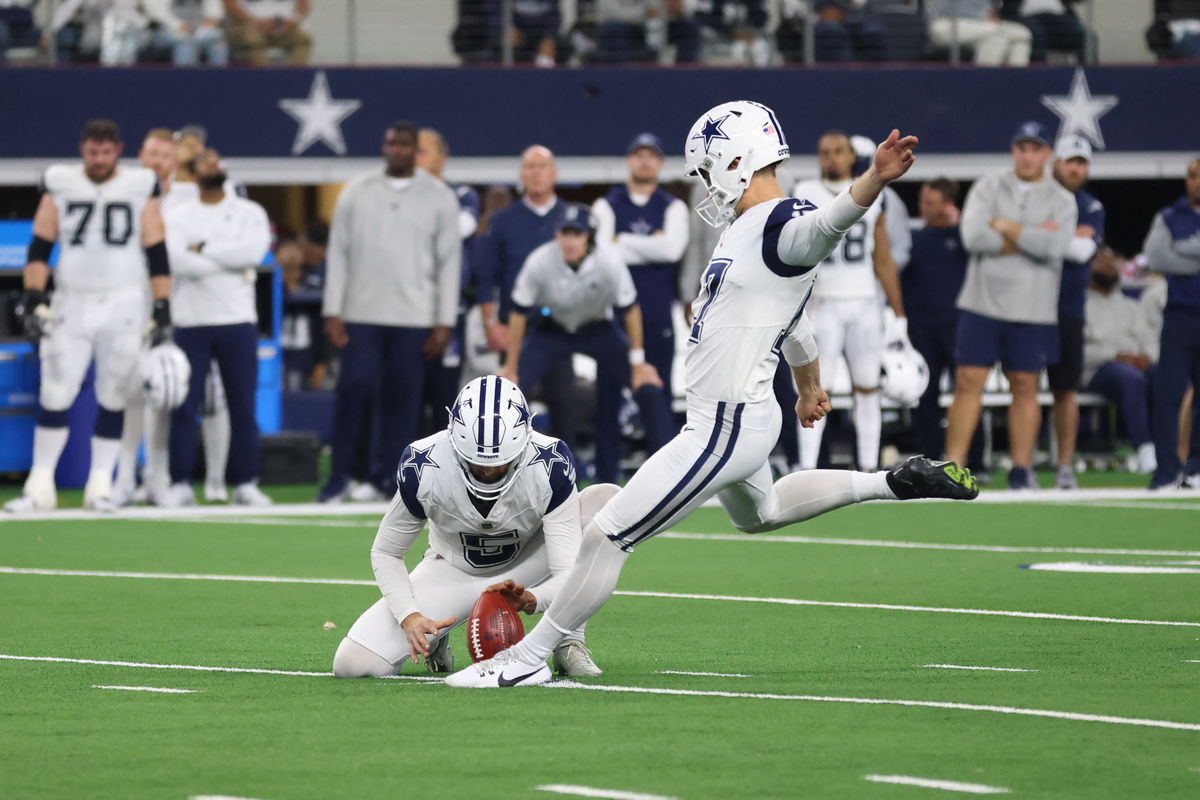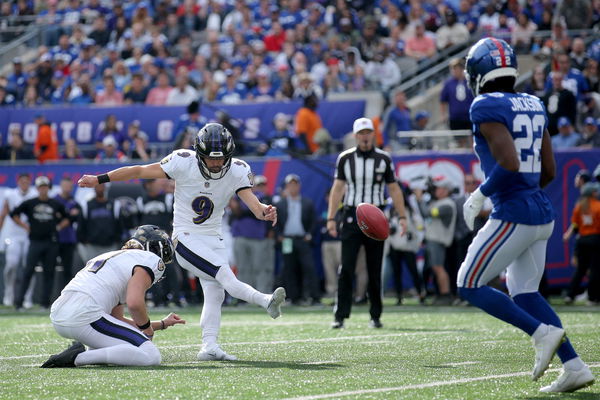
USA Today via Reuters
Dec 10, 2023; Arlington, Texas, USA; Dallas Cowboys place kicker Brandon Aubrey (17) kicks a field goal in the fourth quarter against the Philadelphia Eagles at AT&T Stadium. Mandatory Credit: Tim Heitman-USA TODAY Sports

USA Today via Reuters
Dec 10, 2023; Arlington, Texas, USA; Dallas Cowboys place kicker Brandon Aubrey (17) kicks a field goal in the fourth quarter against the Philadelphia Eagles at AT&T Stadium. Mandatory Credit: Tim Heitman-USA TODAY Sports
Imagine lining up for a long field goal in the fourth quarter, only to realize the ball still feels like it’s straight out of the box. That’s how K-balls — the specially marked footballs reserved for kicking — have played out in the NFL for years. But according to Mike Tirico, that’s about to change. And that’s heaven for specialists.
Watch What’s Trending Now!
Yes, Tirico revealed that teams will now be allowed to prepare their K-balls before game day, just like they do with regular game balls. And why does it matter? For kickers, even small differences in the feel and history of a football can affect grip and flight. And now we might see cleaner kicks and smoother snaps. It might not literally be an extra 10 or 15 yards, but it’s still big for kickers.
Let’s start from scratch. “K-balls” are the weird little subplot that just won’t die. They’re the shiny, straight-out-of-the-box footballs the league forces onto special-teams plays, supposedly to curb touchbacks and spice up kickoffs. But ask any kicker or snapper and you’ll get the same eye roll.
ADVERTISEMENT
Tirico just said that the K Balls are allowed to be brought to the game by the teams this year..this is a HUGE deal for ball kickers/snappers
In my estimation..there’s a 10-15 yard swing in a well broken in ball vs a ball fresh out of the box
Gonna be a GREAT year #ForTheBrand
— Pat McAfee (@PatMcAfeeShow) September 5, 2025
For them, they’re rock-hard bricks compared to the broken-in game balls. Slippery to hold, awkward to catch, and a nightmare to bomb for distance. Guys have been griping about them forever, and honestly, you can see why every time one comes off a foot like a cinder block.
Before the tweak, the rulebook was brutal about K-balls: every team had to cough up 12 primaries, 12 backups, and three specially marked kicking balls for inspection exactly 2 hours and 15 minutes before kickoff.
ADVERTISEMENT
So basically, there was no time to break them in during the week like you can with normal game balls. That language is technically still on the books, but the new resolution finally gives teams a break — letting them prep K-balls in advance under the same process as the regular ones.
And as McAfee remarked, the game definitely will be better with this new rule.
ADVERTISEMENT
Pat McAfee’s 10-15 yard swing claim
When Pat McAfee wrote that “there’s a 10-15 yard swing in a well broken-in ball vs a ball fresh out of the box,” he wasn’t making it up. Ask any kicker (or just watch one glare at a rock-hard new ball), and you’ll understand. The difference between a fresh K-Ball and a broken-in ball is staggering.
They come out slick, stiff, sometimes even a little lopsided, and that factory gloss makes them tough to steer or get a clean strike on. Guys have been caught in warmups, squeezing, scuffing, and basically begging the ball to loosen up so it flies the way it’s supposed to.
ADVERTISEMENT

USA Today via Reuters
Oct 16, 2022; East Rutherford, New Jersey, USA; Baltimore Ravens place kicker Justin Tucker (9) kicks a field goal during the third quarter against the New York Giants at MetLife Stadium. Mandatory Credit: Brad Penner-USA TODAY Sports
It’s basic physics. Even the tiniest tweaks—how the surface feels, how the seams line up can mess with the ball’s trajectory. Add in the way it comes off the foot (speed and spin), and suddenly you’re talking about real changes in distance and accuracy on kicks and punts. So a 10-15 yard swing is a legitimate prediction.
Top Stories
Tom Brady Makes Career Announcement for Vegas as Pete Carroll Addresses Losing Raiders Locker Room

Cam Newton Makes NFL Return Conditions Clear to 32 Teams as Panthers Legend Confirms Retirement Stance

Dolphins’ Jordyn Brooks Publicly Calls Out Locker Room Over ‘Poor’ Performance Against Steelers

Andy Reid Makes Final Decision on Signing New Chiefs QB After Patrick Mahomes’ ACL Injury

Patrick Mahomes Successfully Undergoes Surgery as Andy Reid Highlights Chiefs QB’s Recovery Plan

We also have the cold numbers from last year to underscore the importance of this change. Justin Tucker (generally considered the all-time benchmark for accuracy) had a down year last season, converting 73.3% of his field-goal attempts. So, yes, this is a shot at more drama, longer kicks, and a content bonanza for shows that live off late-game chaos. Like Pat McAfee framed it, “Gonna be a GREAT year #ForTheBrand“
ADVERTISEMENT
ADVERTISEMENT
ADVERTISEMENT
ADVERTISEMENT

